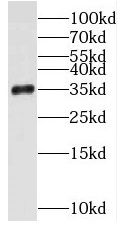Products
STUB1 antibody
Category:
Research Area:
- SPECIFICATIONS
- Product Name
- STUB1 antibody
- Catalogue No.
- FNab08357
- Size
- 100μg
- Form
- liquid
- Purification
- Immunogen affinity purified
- Purity
- ≥95% as determined by SDS-PAGE
- Clonality
- polyclonal
- Isotype
- IgG
- Storage
- PBS with 0.02% sodium azide and 50% glycerol pH 7.3, -20℃ for 12 months(Avoid repeated freeze / thaw cycles.)
Immunogen
- Immunogen
- STIP1 homology and U-box containing protein 1
- Alternative Names
- CHIP antibody
- UniProt ID
- Q9UNE7
- Observed MW
- 35 kDa
Application
- Tested Applications
- ELISA, WB, IHC
- Recommended dilution
- WB: 1:500-1:2000; IHC: 1:20-1:200
Validated Images
 HeLa cells were subjected to SDS PAGE followed by western blot with FNab08357(STUB1 antibody) at dilution of 1:500
HeLa cells were subjected to SDS PAGE followed by western blot with FNab08357(STUB1 antibody) at dilution of 1:500
 Immunohistochemistry of paraffin-embedded human heart using FNab08357(STUB1 antibody) at dilution of 1:50
Immunohistochemistry of paraffin-embedded human heart using FNab08357(STUB1 antibody) at dilution of 1:50
- Background
- E3 ubiquitin-protein ligase which targets misfolded chaperone substrates towards proteasomal degradation. Collaborates with ATXN3 in the degradation of misfolded chaperone substrates: ATXN3 restricting the length of ubiquitin chain attached to STUB1/CHIP substrates and preventing further chain extension. Ubiquitinates NOS1 in concert with Hsp70 and Hsp40. Modulates the activity of several chaperone complexes, including Hsp70, Hsc70 and Hsp90. Mediates transfer of non-canonical short ubiquitin chains to HSPA8 that have no effect on HSPA8 degradation. Mediates polyubiquitination of DNA polymerase beta(POLB) at 'Lys-41', 'Lys-61' and 'Lys-81', thereby playing a role in base-excision repair: catalyzes polyubiquitination by amplifying the HUWE1/ARF-BP1-dependent monoubiquitination and leading to POLB-degradation by the proteasome. Mediates polyubiquitination of CYP3A4. Ubiquitinates EPHA2 and may regulate the receptor stability and activity through proteasomal degradation. Negatively regulates the suppressive function of regulatory T-cells(Treg) during inflammation by mediating the ubiquitination and degradation of FOXP3 in a HSPA1A/B-dependent manner(PubMed:23973223).



